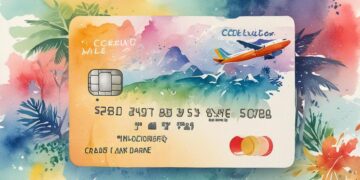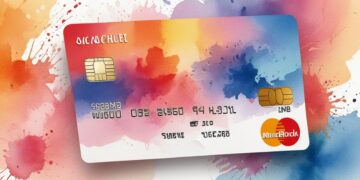How to Choose the Ideal Credit Card for Your Financial Needs

Evaluating Your Spending Habits
To choose the right credit card, start with an in-depth evaluation of your spending habits. Being aware of where your money goes each month can greatly enhance your credit card selection process.
- Rewards programs – If you travel frequently, seek out cards that offer enhanced travel rewards, such as airline miles or hotel points. For example, a card like the Chase Sapphire Preferred® offers 2x points on travel and dining. This can be beneficial if these categories match your spending habits.
- Cash back benefits – If your grocery expenses take a significant chunk of your budget, look for credit cards that provide cash back in this category. The Blue Cash Preferred® Card from American Express, for instance, gives 6% cash back on supermarkets (up to $6,000 per year), making it an excellent choice for families or those who cook at home frequently.
- Interest rates – Understanding the card’s Annual Percentage Rate (APR) is crucial, especially if you anticipate carrying a balance. A low APR, like that offered by some credit unions or promotional balance transfer cards, helps you minimize interest if you don’t pay off the balance in full each month.
Assessing Fees Associated With the Card
After analyzing your spending habits, the next step involves understanding the fees attached to potential credit cards. This information is vital for avoiding surprises later on.
- Annual fees – Some credit cards come with hefty annual fees that can outweigh the benefits they provide. For example, the Platinum Card® from American Express charges a high annual fee but offers extensive travel perks. Weigh these fees against the rewards you’ll actually use.
- Foreign transaction fees – If you travel outside the United States, look for cards that waive foreign transaction fees, as these can range from 1% to 3% of every transaction. Cards like the Capital One Venture Rewards Credit Card typically do not impose this fee, making them suitable for international travelers.
- Late payment fees – Familiarize yourself with the penalty structure for late payments. Many credit cards can charge fees of up to $40 for missed deadlines, which can add up quickly if you forget.
Understanding Your Credit Score
Your credit score plays a significant role in the credit cards you can qualify for, influencing both the rewards and fees associated with the card. Generally, a score of 700 and above is considered good, which enables access to cards with better terms.
Checking your credit score is easy, with several free online tools available. This way, you can gauge what cards might suit you best. If your score is lower than the desired range, consider taking steps to improve it, such as paying off existing debts or ensuring timely bill payments.
By methodically evaluating your spending habits, understanding associated fees, and knowing your credit score, you can efficiently narrow down your options for credit cards. This focused approach will lead you to a card that not only fulfills your financial needs but also complements your lifestyle.
DISCOVER MORE: Click here for a quick application guide
Identifying the Key Features You Need
Understanding your spending habits is crucial for making informed financial decisions. The next step involves identifying the key features that align with your individual financial needs and lifestyle. Since not all credit cards have the same attributes, selective consideration can significantly influence your financial well-being over time.
- Credit limit – Assess what credit limit fits your financial picture. If you tend to make substantial purchases, such as electronics or home improvements, opting for cards that offer higher credit limits is advisable. A higher credit limit not only accommodates your buying patterns but also can enhance your credit utilization ratio. This ratio is a vital factor in determining your credit score; ideally, you should keep your utilization below 30% to maintain a healthy score.
- Additional incentives – Investigate credit cards that provide welcome bonuses for new applicants. For example, some cards may offer a bonus of 50,000 points after you spend $3,000 in the first three months. Such bonuses can translate into significant savings, particularly during months when you have planned expenses, like holiday shopping or vacations. Always read the fine print to ensure you can comfortably meet the spending requirement without falling into debt.
- Flexible payment options – Evaluate whether the card offers flexible payment arrangements. Some issuers allow you to select your due date or offer flexible installment plans for purchases. This can help you manage cash flow more smartly, especially if your income is variable, allowing payments to align with your pay schedule and reducing the need to juggle bills.
Exploring Additional Benefits
Once you’ve pinpointed essential features, it’s time to delve into additional benefits that various credit cards offer. These perks can enhance your user experience and lead to considerable savings, making them worth your attention.
- Purchase protection – Many credit cards provide purchase protection, which reimburses you in case of damage or theft of eligible items purchased with the card. This is especially important for high-value purchases, granting you peace of mind and financial security.
- Extended warranty – Look for credit cards that extend warranty coverage on eligible purchases. This means that if an item breaks after the manufacturer’s warranty expires, the credit card might cover repairs or replacements, saving you out-of-pocket expenses.
- Travel benefits – If you’re a frequent traveler, prioritize credit cards that offer travel-specific perks, such as complimentary travel insurance, access to airport lounges, or rental car insurance. These benefits add significant value by improving your travel experience while safeguarding against unforeseen expenses incurred during travel.
By meticulously identifying the features essential to your financial needs and examining additional benefits that resonate with your lifestyle, you equip yourself to choose a credit card that effectively serves your purpose. This systematic approach ensures that the card you select not only facilitates your financial goals but also enhances your overall financial health.
DISCOVER MORE: Click here to unlock your potential
Understanding Fees and Interest Rates
An essential aspect of choosing a credit card is a clear understanding of the associated fees and interest rates. Failing to account for these can lead to unexpected costs that burden your finances over time. Here are the key areas to scrutinize:
- Annual fees – Some credit cards charge an annual fee, which can range from $0 to several hundred dollars. Evaluate whether the benefits offered by the card justify the expense. For instance, if a card with a $95 annual fee offers cash back rewards that exceed this cost, it might be worth considering. Conversely, if you do not expect to utilize the benefits, a no-annual-fee card may be the better option for your financial health.
- APR (Annual Percentage Rate) – Be sure to check the APR associated with each card, as this will directly affect how much you pay in interest on any balances carried after the due date. A lower APR is ideal, especially for individuals who may not pay off their balances in full each month. For example, a card with a 15% APR will cost you less in interest than one with a 22% APR on the same outstanding balance.
- Foreign transaction fees – If you plan on traveling abroad or making purchases from international merchants, check for foreign transaction fees. These typically range from 1% to 3% of each transaction made outside the United States. A card that does not charge foreign transaction fees can save you substantial amounts if you regularly make international purchases or travel frequently.
Evaluating Credit Card Offers
With the plethora of credit card offers available, it’s essential to evaluate each based on how well they align with your specific requirements. Use the following strategies to effectively sift through the options:
- Compare rewards programs – Not all rewards programs are created equal. Some cards offer points, while others provide cash back or miles. Determine what type of rewards will be most beneficial to you. For instance, if you frequently travel, a card that offers airline miles may be advantageous. In contrast, if you tend to dine out often, a card offering increased cash back on dining purchases might be more suitable.
- Read user reviews – Before applying for a card, research user reviews online. Pay attention to feedback regarding the application process, customer service experience, and ease of redeeming rewards. User experiences can highlight potential concerns or advantages that may not be immediately evident from promotional materials.
- Check for introductory offers – Many credit cards provide enticing introductory offers, such as 0% APR for the first 12-18 months or bonus rewards points that can be earned if a spending threshold is met within a specific timeframe. Assess these offers critically and ensure that you can leverage them effectively without overstretching your budget.
By thoroughly examining fees and rates as well as effectively evaluating different offers, you’ll gain a clearer perspective on which credit card suits your finances best. This strategic approach not only helps in selecting a card but also ensures that you maintain control over your financial well-being moving forward.
DON’T MISS OUT: Click here for tips on applying with bad credit
Conclusion
Choosing the ideal credit card is a multi-faceted decision that requires careful consideration of various factors tailored to your individual financial needs. Start by clearly identifying your primary use for the card—whether it’s for travel rewards, cash back, or building credit. Next, thoroughly assess the fees and interest rates associated with each option; pay close attention to their annual fees, APRs, and foreign transaction fees, as these can significantly affect your overall costs.
Additionally, take the time to evaluate rewards programs according to your lifestyle. What may work best for one individual might not suit another. Consider user reviews for firsthand experiences that provide insights beyond marketing claims, allowing you to make an informed decision. Lastly, don’t overlook introductory offers which can provide short-term benefits, but ensure they align with your long-term spending habits to prevent financial strain.
By following these steps, you’ll not only find a credit card that meets your unique needs but also harness its potential effectively. This proactive approach will enable you to maximize rewards, reduce costs, and maintain a healthy credit profile, leading to enhanced financial well-being. Always remember, the best credit card is one that complements your spending habits while helping you achieve your financial goals efficiently.

Linda Carter is a writer and financial expert specializing in personal finance and financial planning. With extensive experience helping individuals achieve financial stability and make informed decisions, Linda shares her knowledge on the Take Care Garden platform. Her goal is to empower readers with practical advice and strategies for financial success.





